
The 1948 Arab–Israeli War, also known as the First Arab–Israeli War, followed the civil war in Mandatory Palestine as the second and final stage of the 1948 Palestine war. It formally began following the end of the British Mandate for Palestine at midnight on 14 May 1948; the Israeli Declaration of Independence had been issued earlier that day, and a military coalition of Arab states entered the territory of Mandatory Palestine in the morning of 15 May.
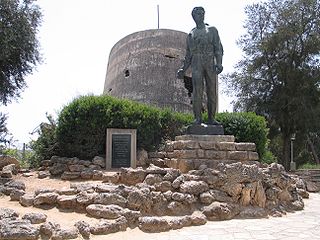
Yad Mordechai is a kibbutz in Southern Israel. Located 10 km south of Ashkelon, it falls under the jurisdiction of Hof Ashkelon Regional Council. In 2021 it had a population of 792.

Operation Yoav was an Israeli military operation carried out from 15–22 October 1948 in the Negev Desert, during the 1948 Arab–Israeli War. Its goal was to drive a wedge between the Egyptian forces along the coast and the Beersheba–Hebron–Jerusalem road, and ultimately to conquer the whole Negev. Operation Yoav was headed by the Southern Front commander Yigal Allon. The operation was named after Yitzhak Dubno, codenamed "Yoav" by his commanders in the Palmach. Dubno, a senior Palmach officer, was charged with planning and leading the defense of the kibbutzim Negba and Yad Mordechai. Dubno was killed in an air raid on Kibbutz Negba shortly after Egyptian forces began their offensive on Israel's southern front.

The 1st "Golani" Brigade is an Israeli military infantry brigade. It is subordinated to the 36th Division and traditionally associated with the Northern Command. It is one of the five infantry brigades of the regular Israel Defense Forces (IDF), the others being the Paratroopers Brigade, the Nahal Brigade, the Givati Brigade and the Kfir Brigade. Its symbol is a green olive tree against a yellow background, with its soldiers wearing a brown beret. It is one of the most highly decorated infantry units in the IDF. The brigade consists of five battalions, including two which it kept from its inception, one transferred from the Givati Brigade (51st).
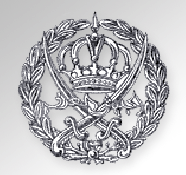
The Arab Legion was the police force, then regular army, of the Emirate of Transjordan, a British protectorate, in the early part of the 20th century, and then of the Hashemite Kingdom of Jordan, an independent state, with a final Arabization of its command taking place in 1956, when British senior officers were replaced by Jordanian ones.

The Battle of Karameh was a 15-hour military engagement between the Israel Defense Forces (IDF) and combined forces of the Palestine Liberation Organization (PLO) and the Jordanian Armed Forces (JAF) in the Jordanian border town of Karameh on 21 March 1968, during the War of Attrition. It was planned by Israel as one of two concurrent raids on PLO camps, one in Karameh and one in the distant village of Safi.
Ahmed Abdullah Al-Mwawi (1897–1979), also Mawawi or Muwawi, was an Egyptian major general. He served as the General Commander of the Egyptian expeditionary force during 1948 Arab–Israeli War.

The Battles of Latrun were a series of military engagements between the Israel Defense Forces and the Jordanian Arab Legion on the outskirts of Latrun between 25 May and 18 July 1948, during the 1948 Arab–Israeli War. Latrun takes its name from the monastery close to the junction of two major highways: Jerusalem to Jaffa/Tel Aviv and Gaza to Ramallah. During the British Mandate it became a Palestine Police base with a Tegart fort. The United Nations Resolution 181 placed this area within the proposed Arab state. In May 1948, it was under the control of the Arab Legion. It commanded the only road linking the Yishuv-controlled area of Jerusalem to Israel, giving Latrun strategic importance in the battle for Jerusalem.

The Battles of the Kinarot Valley, is a collective name for a series of military engagements between the Haganah and the Syrian army during the 1948 Arab–Israeli War, fought between 15–22 May 1948 in the Kinarot Valley. It includes two main sites: the Battle of Degania–Samakh (Tzemah), and battles near Masada–Sha'ar HaGolan. The engagements were part of the battles of the Jordan Valley, which also saw fighting against Transjordan in the area of Gesher.
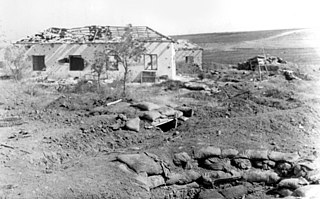
The Battle of Nitzanim was a battle fought between the Israel Defense Forces and the Egyptian Army in the 1948 Arab–Israeli War, on June 7, 1948. It was the first major Egyptian victory of the war, and one of the few cases of Israeli surrender.

Operation Pleshet was an Israeli military action near the village of Isdud from May 29 to June 3, 1948 during the 1948 Arab–Israeli War. Isdud was on the Israeli southern front against the Egyptian Army, and the operation was aimed at capturing the village and stopping the Egyptian advance northwards. While only the June 2–3 engagements are officially named Operation Pleshet, the events immediately preceding are historiographically joined with it.

The Battle of Nirim was a military engagement between the Egyptian army and the Jewish Haganah militia on May 15, 1948, the first day of the Egyptian invasion of Israel in the 1948 Arab–Israeli War. It was fought in kibbutz Nirim, founded just two years earlier as part of the strategic settlement push known as the "11 points in the Negev". The Egyptian 6th Battalion attacked about 40 Israeli defenders at dawn on May 15, backed by armored vehicles, mortars, cannons and aircraft. They failed to take the village and retreated about 7 hours later, leaving behind about 30–35 dead.
The Battles of Kfar Darom refer to a number of military engagements in 1947–1948 between the Jewish Haganah and various Arab forces in the 1948 Arab–Israeli War, in the southern kibbutz Kfar Darom. The most notable battles were fought on May 13–15, 1948, between the Palmach and the Egyptian army, including Muslim Brotherhood units. The kibbutz was defended by about 30 Israelis and held out against numerous attacks.
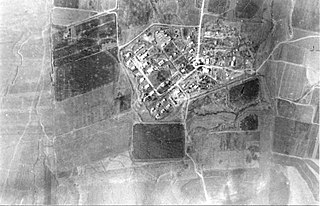
The Battles of Negba were a series of military engagements between the Israel Defense Forces and the Egyptian army in the 1948 Arab–Israeli War. Negba, a kibbutz founded in 1939, had a strategic position overlooking the Majdal – Bayt Jibrin road, and was a target of two major assaults by the Egyptians in June and July 1948.

The Battle of Be'erot Yitzhak was a military engagement between the Israel Defense Forces and Egyptian army in the 1948 Arab–Israeli War. It was fought on July 15, 1948, in the ten-day period between the first and second truces of the war.
Operation Death to the Invader, also Death to the Invaders, was an Israeli military operation during the 1948 Arab–Israeli War. It was carried out on July 16–18, 1948 in the northwestern Negev desert. The operation's objective was to link Jewish villages in the Negev desert with the rest of Israel, after this aim was not achieved in Operation An-Far that ended on July 15. The Egyptians blocked Israeli access to its Negev villages during the first truce of the war, by taking up positions on the Majdal – Bayt Jibrin road, where most of the battles of Death to the Invaders were fought.
The Battle of Hill 86 was a military engagement between the Israel Defense Forces and the Egyptian Army as part of Operation Horev. It was fought on December 22–23, 1948, and was the first battle of the operation. The Israelis initiated the battle, as well as a concurrent raid on the Arab village of 'Abasan and aerial and naval shelling of the coastal strip, with the hope of deceiving the Egyptians into thinking that the coming operation would be aimed at isolating the Egyptian forces in Gaza.
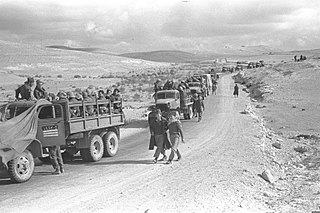
The Battle of Rafah was a military engagement between the Israel Defense Forces and the Egyptian Army in the final stage of the 1948 Arab–Israeli War. It was fought on January 3–8, 1949, just south of Rafah, today in the Gaza Strip. The battle was initiated by Israel as part of Operation Horev, on the backdrop of the Sinai battles just before. The Israelis were hoping to encircle all Egyptian forces in Palestine and drive them back to Egypt.

This article deals with the history and development of tanks of the Israeli Army, from their first use after World War II in the establishment of the State of Israel after the end of the British Mandate, and into the Cold War and what today is considered the modern era.

The 1948 Palestine war was fought in the territory of what had been, at the start of the war, British-ruled Mandatory Palestine. It was the first war of the Israeli–Palestinian conflict and the broader Arab–Israeli conflict. During the war, the British withdrew from the territory and the State of Israel was established, leading to it being known in Israel as the War of Independence.


















